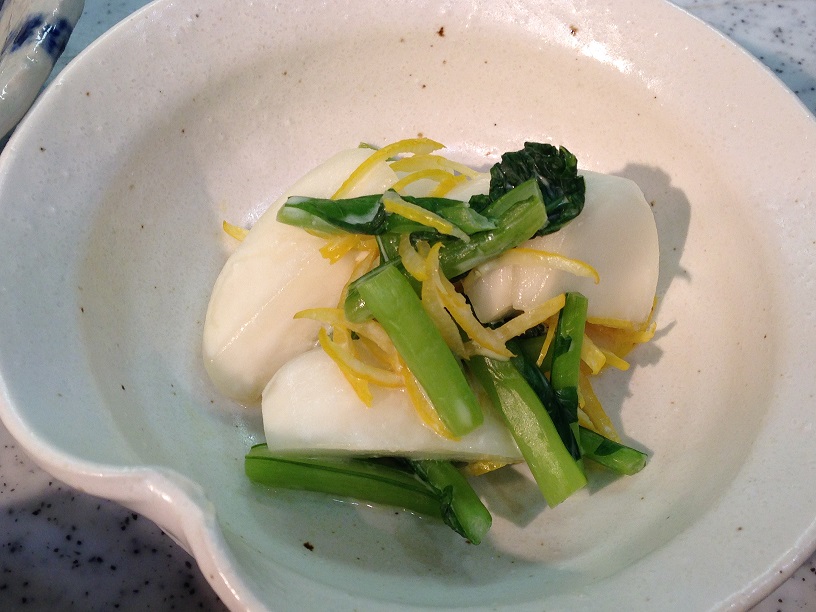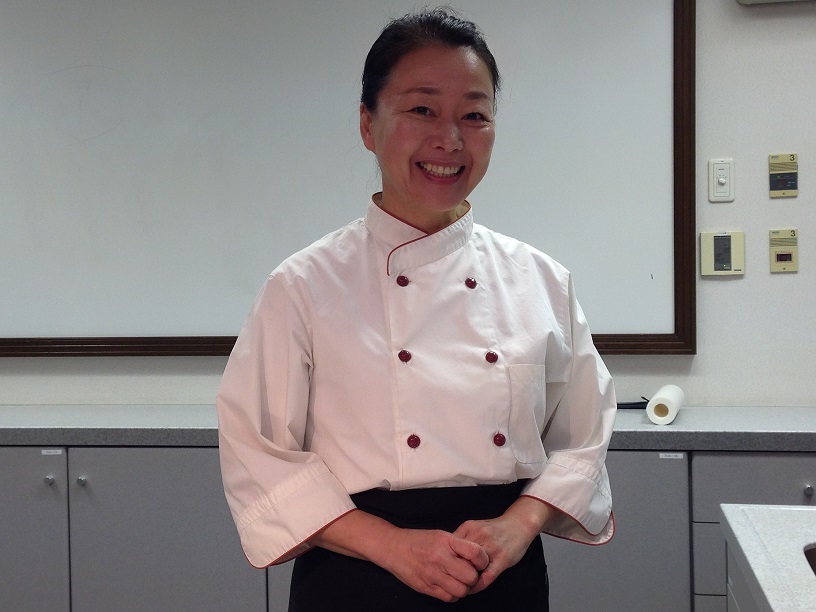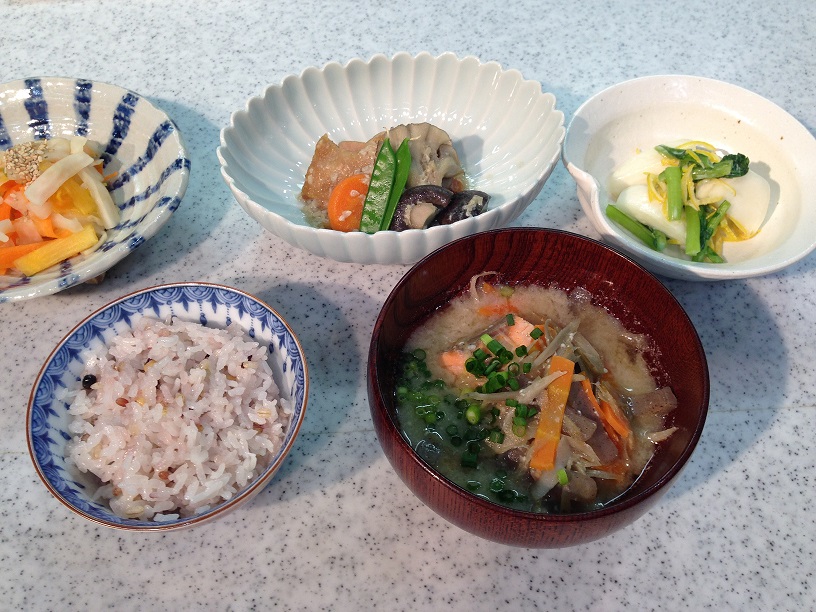A Cooking Class in Japan
 Monday, October 20, 2014 at 4:00AM
Monday, October 20, 2014 at 4:00AM 
By Sandy Hu
The latest from Inside Special Fork
One of the most delicious meals I've had in Japan, to date, was at a Kikkoman consumer cooking class held at the company's Tokyo office on Friday. The theme was washoku, traditional Japanese cooking.
Of course, it didn't hurt that the class was taught by renowned chef Chisako Hori, managing director of Kikunoi, a restaurant group that was awarded three Michelin stars for its main restaurant in Kyoto. She is also chef-owner and nutritionist at the anti-aging restaurant, Rire.
I have a history with Kikkoman, having grown up with its soy sauce, as my mother and grandmother before me. Kikkoman is a family business that goes back 19 generations and if I could trace my family back to Japan, they were probably Kikkoman users, too.
Kikkoman also was my client in the U.S. when I worked at Ketchum, the global communications firm. I spent many years educating food media and consumers about the difference between naturally brewed soy sauce like Kikkoman, and the unbrewed variety.
Like fine wine, naturally brewed soy sauce is aged to bring out umami flavors. If you don't know the difference between the naturally brewed product and the ones that try to shortcut the aging process by adding caramel coloring and corn syrup, just do a side-by-side comparison -- tasting, smelling and visually assessing the difference. You'll become an instant convert.
My friends at Kikkoman in the U.S. kindly arranged for my enrollment in the Friday cooking class, which is not a class for tourists, but for Japanese people -- mostly young women -- who would like to learn to cook their culinary heritage.
I was hosted by Ken Sugiura, Assistant Manager of Kikkoman's Business Planning Group, Foreign Operations Department; and Mariko Tachikawa, of the Foreign Administration Department.
I learned that among Kikkoman's wide-ranging Japanese consumer outreach programs, which include a  meal-planning recipe app, recipe books and a robust Japanese website, the company is championing washoku, the culinary heritage of Japan.
meal-planning recipe app, recipe books and a robust Japanese website, the company is championing washoku, the culinary heritage of Japan.
Kikkoman is helping Japanese people to rediscover and embrace washoku, in a time when home cooks are focused on convenience and adopting more foreign foods and eating habits.
Last year, UNESCO registered washoku as an Intangible Cultural Heritage. In applying for this status, the Japanese government gave four characteristics of washoku 1) Diversity and freshness of ingredients and respect for their inherent flavors, 2) An exceptionally well-balanced and healthy diet, 3) An expression of natural beauty and changing seasons and 4) Close links with annual events (that ensure a continuity and perpetuation of the cuisine).
Among its activities promoting washoku, Kikkoman has held a panel discussion with renowned chefs, and cooking classes, such as the one I attended.
The theme on Friday was fermented foods and Chef Hori incorporated such ingredients as shio koji, a fermented mixture of koji (rice inoculated with a special mold, Aspergillus oryzae), salt and water; sake lees (the rice paste left over from making sake); and yogurt.
Her menu for the evening:
Chicken and Mushroom Salted Koji Stew
Vinegar Seasoned Persimmon
Turnip and Yuzu Pickled in Soy Sauce Yogurt
Sake Lees Soup with Salmon and Burdock Root
Rice with Ten Grains
Since the class was conducted in Japanese, I was grateful to Ken, my host, an excellent translator, who kept me informed as we watched the cooking demonstration.
As she deftly prepared the dishes, Chef Hori provided invaluable cooking tips:
- To brown chicken that will be cooked later in a sauce: start the chicken, skin-side down, in a cold, nonstick pan. Cook over low heat until browned. This will draw out the oil. Brown just one side of the chicken so the meat can absorb the sauce as it cooks.
- Slice vegetables like daikon and carrots lengthwise instead of crosswise, cutting along the fibers, to maintain a crisp texture.
- A 3 percent salt water solution is a good proportion when soaking vegetables in salt water to draw out moisture.
- To sauté mushrooms, never add oil. Just pan fry over low heat in a nonstick pan. If you need oil, add it after the mushrooms are cooked. (Mushrooms are like sponges and they'll continue to absorb oil if added from the start.)
- To season with less sodium, use ingredients that are high in umami, such as mushrooms. Or add aromatic ingredients like sesame seeds or mitsuba (trefoil) leaves.
- When simmering vegetables, peel them deeply first to allow vegetables to absorb flavor.
- Always utilize citrus skin. It is high in vitamin P, a flavonoid for healthy blood vessels.
- To scale salmon, immerse in boiling water three to five seconds, then plunge in a bowl of cold water. Use fingers to scrape off any scales. Also scrape off the black color of the skin when using the salmon in a white dish, such as a clear soup.

Here is a recipe from the Kikkoman Washoku class. We'll post more recipes later on our Facebook page.
Turnip and Yuzu Pickled in Soy Sauce Yogurt
Serves 2
2 Japanese turnips
1 ounce turnip leaves
1 teaspoon Kikkoman naturally brewed soy sauce
1 ounce plain yogurt
Julienned peel from 1/2 of a yuzu
Cut turnips into wedges and peel them. Parboil turnip leaves in boiling water for 20 seconds; drain and plunge leaves in a bowl of cold water to stop the cooking process. Drain and squeeze dry. Cut into 1 1/4-inch lengths.
In zip top plastic bag, add soy sauce, yogurt, turnips and turnip leaves; seal and shake well to combine; set aside 10 minutes.
Arrange turnips and turnip leaves in two small dishes. Dress with yuzu peel and serve.
Recipe adapted from Chef Chisako Hori at the Kikkoman cooking class, Tokyo.
Note: Yuzu is a Japanese citrus fruit that is now found in some American markets. It has a distinctive flavor; the closest mainstream option is lime.
You can find more English recipes on the Kikkoman USA website.
For more about Japan, please follow my trip here on the Special Fork blog, as well as on Instagram, Twitter and Facebook.
Special Fork is a recipe website for your smartphone and PC that solves the daily dinnertime dilemma: what to cook now! Check out our recipe database for quick ideas that take no more than 30 minutes of prep time. Follow us on Facebook , Twitter, Pinterest, and YouTube.
Related posts:
Reader Comments